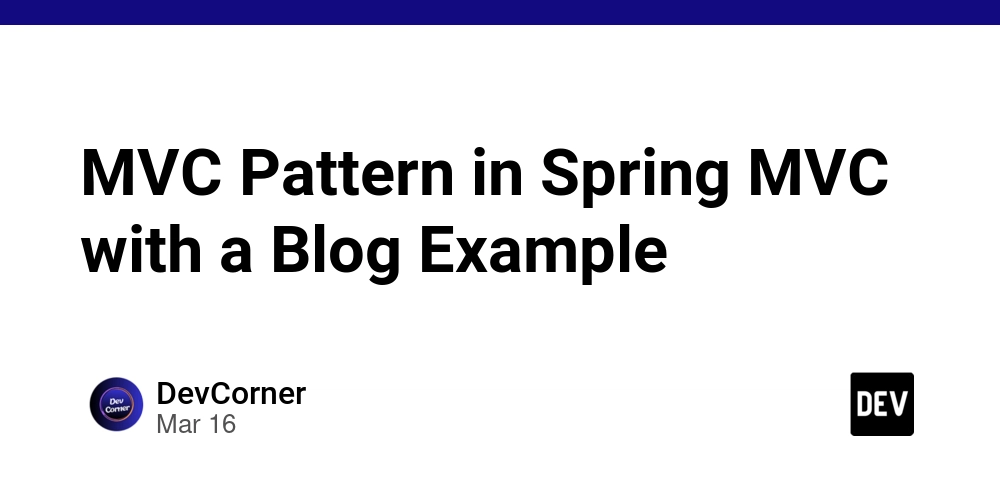MVC Pattern in Spring MVC with a Blog Example
The Model-View-Controller (MVC) pattern is a design pattern that separates an application into three components: Model → Represents the data and business logic. View → Handles the UI/Presentation layer. Controller → Handles user requests, processes them, and sends data to the view. Spring MVC follows this pattern to build web applications in a structured and maintainable way. Let’s understand this with a blog application example where users can create, view, and manage blog posts. 1. Components of MVC in a Spring MVC Blog 1.1 Model (Data + Business Logic) The Model represents the blog post data and handles business logic. In Spring MVC, it is typically implemented using Java classes (POJOs), JPA/Hibernate entities, and Service Layer. Example: BlogPost Model @Entity public class BlogPost { @Id @GeneratedValue(strategy = GenerationType.IDENTITY) private Long id; private String title; private String content; private LocalDateTime createdAt; // Constructors, Getters, Setters } 1.2 View (User Interface) The View is responsible for rendering the response. In Spring MVC, the view is typically implemented using Thymeleaf, JSP, or other frontend technologies like React/Angular. Example: Thymeleaf View (blog.html) Blog Posts All Blog Posts Published on: 1.3 Controller (Handles Requests) The Controller manages incoming HTTP requests, processes data using the Model, and returns the appropriate View. In Spring MVC, controllers are implemented using @Controller or @RestController annotations. Example: BlogController @Controller @RequestMapping("/blog") public class BlogController { @Autowired private BlogService blogService; // Show all blog posts @GetMapping public String listPosts(Model model) { List posts = blogService.getAllPosts(); model.addAttribute("posts", posts); return "blog"; // Refers to blog.html } // Show the form to create a new post @GetMapping("/new") public String newPostForm(Model model) { model.addAttribute("blogPost", new BlogPost()); return "newPost"; // Refers to newPost.html } // Handle form submission for new post @PostMapping public String savePost(@ModelAttribute BlogPost blogPost) { blogService.savePost(blogPost); return "redirect:/blog"; // Redirect to list all posts } } 2. How MVC Works in Spring MVC (Request Flow) Example Scenario: A User Requests a Blog Post List User sends a request to /blog → GET /blog request is sent to BlogController. Controller Processes Request → listPosts(Model model) method fetches blog posts from BlogService. Model Passes Data to View → model.addAttribute("posts", posts); sends blog data to the view. View Displays Data → blog.html renders the list of blog posts with Thymeleaf. 3. Advantages of Using MVC in Spring MVC ✅ Separation of Concerns – Keeps business logic (Model), request handling (Controller), and UI (View) separate. ✅ Scalability – New features can be added easily. ✅ Maintainability – Easier to debug and update code. ✅ Reusable Components – Models and Views can be reused across multiple controllers. Final Thoughts Spring MVC provides a structured way to develop web applications using the MVC pattern. In a blog application, the Model (BlogPost) handles data, the View (Thymeleaf/JSP) renders UI, and the Controller (BlogController) processes requests. This architecture makes the application clean, maintainable, and scalable.

The Model-View-Controller (MVC) pattern is a design pattern that separates an application into three components:
- Model → Represents the data and business logic.
- View → Handles the UI/Presentation layer.
- Controller → Handles user requests, processes them, and sends data to the view.
Spring MVC follows this pattern to build web applications in a structured and maintainable way. Let’s understand this with a blog application example where users can create, view, and manage blog posts.
1. Components of MVC in a Spring MVC Blog
1.1 Model (Data + Business Logic)
The Model represents the blog post data and handles business logic. In Spring MVC, it is typically implemented using Java classes (POJOs), JPA/Hibernate entities, and Service Layer.
Example: BlogPost Model
@Entity
public class BlogPost {
@Id
@GeneratedValue(strategy = GenerationType.IDENTITY)
private Long id;
private String title;
private String content;
private LocalDateTime createdAt;
// Constructors, Getters, Setters
}
1.2 View (User Interface)
The View is responsible for rendering the response. In Spring MVC, the view is typically implemented using Thymeleaf, JSP, or other frontend technologies like React/Angular.
Example: Thymeleaf View (blog.html)
xmlns:th="http://www.thymeleaf.org">
</span>Blog Posts<span class="nt">
All Blog Posts
th:each="post : ${posts}">
th:text="${post.title}">
th:text="${post.content}">
Published on: th:text="${post.createdAt}">











































































































































































![[The AI Show Episode 142]: ChatGPT’s New Image Generator, Studio Ghibli Craze and Backlash, Gemini 2.5, OpenAI Academy, 4o Updates, Vibe Marketing & xAI Acquires X](https://www.marketingaiinstitute.com/hubfs/ep%20142%20cover.png)




























































































































![[DEALS] The Premium Learn to Code Certification Bundle (97% off) & Other Deals Up To 98% Off – Offers End Soon!](https://www.javacodegeeks.com/wp-content/uploads/2012/12/jcg-logo.jpg)


![From drop-out to software architect with Jason Lengstorf [Podcast #167]](https://cdn.hashnode.com/res/hashnode/image/upload/v1743796461357/f3d19cd7-e6f5-4d7c-8bfc-eb974bc8da68.png?#)








































































































.png?#)

































_Christophe_Coat_Alamy.jpg?#)
 (1).webp?#)





































































































![Apple Considers Delaying Smart Home Hub Until 2026 [Gurman]](https://www.iclarified.com/images/news/96946/96946/96946-640.jpg)
![iPhone 17 Pro Won't Feature Two-Toned Back [Gurman]](https://www.iclarified.com/images/news/96944/96944/96944-640.jpg)
![Tariffs Threaten Apple's $999 iPhone Price Point in the U.S. [Gurman]](https://www.iclarified.com/images/news/96943/96943/96943-640.jpg)
































































































































